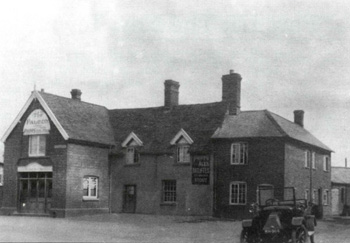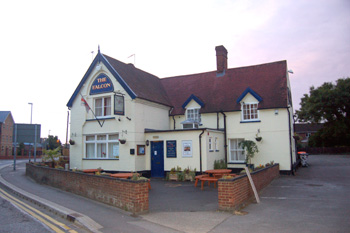The Falcon Public House Leighton Buzzard

The Falcon about 1900
The Falcon Public House: 10 Stanbridge Road, Leighton Buzzard [earlier the Horns & Falcon]
The Manor of Leighton Buzzard alias Grovebury was the principal landowner in the town before the 19th century. Bedfordshire & Luton Archives & Records Service has a full run of court rolls from 1393 to 1727 [KK619-715] and another full run from 1704 to 1867 [X288/1-23]. The service also has court rolls for other manor to own land in the town, the Prebendal Manor, from 1448 to 1459, 1588 to 1591, 1611 to 1622, 1627 and 1631 [KK792-1798]. Detailed study of these would be bound to produce quite full histories for most licensed premises in the town. Unfortunately such study would take a very long time. Thus the histories of licensed premises in these web pages are quite summary and not necessarily the full story.
The first mention of the Falcon so far found is in 1747 when William and Mary Partridge surrendered the copyhold Horns and Falcon, near Leck Bridge, to Mathew Rutley [X288/5]. In 1952, in Volume III of the Bedfordshire Magazine, Page Woodcock stated (page 229): "The Falcon on the Stanbridge Road must be named by coincidence, for as long ago as 1215 the land there was held from the King for the service of taking care of two of his falcons". This may be a confusion with the fact that the nearby Manor of Stanbridge (the Falcon stands in Stanbridge Road), created by King Henry I (1099-1135) for his wife Matilda from the Royal Manor of Leighton, was originally leased at the rent of taking care of two of the King's falcons and paying a £4 per annum rent, to Newnham Priory in Bedford. The former part of the rent was altered in 1258 to an annual payment of £3 to the Exchequer, to be paid to the Chief Falconer.
In the Northampton Mercury of 19th January 1793 licensee of the Falcon, John Felts, subscribed to a resolution of Leighton Buzzard publicans banning "seditious and disaffected persons" from their houses. This presumably was in reaction to the events across the Channel in France (four days previously King Louis XVI had been sentenced to death and two days later he went to the guillotine).
In 1839 the Leighton Buzzard vestry resolved to implement street lighting in the town, the southernmost light being at the Falcon [CRT130Lei5]. In 1844 John Felts or Felce was owner of the Falcon, as well as a considerable amount of land in Billington and Stanbridge Roads. In that year to willed all his property in Leighton Buzzard to his daughter Sarah, who was admitted to it in 1847 [X605/23]. In 1862 Sarah sold all this land to George King for £1,240 plus an annuity of £60 per annum for life [X605/23]. Sarah died in 1866 and King made his will in 1871, devising the land to trustees for sale [X605/23], he died the same year.
In 1872 the trustees Thomas King and John Birdsey sold King's land fronting Billington and Stanbridge Roads, together with sixteen cottages and the Falcon Public House by auction. The Falcon formed Lot 14 which was described as brick built and tiled and "Known as the Falcon Inn, Containing, on the ground floor -Parlour, Taproom, Passage, Kitchen, Coal Cellar and Brewhouse, with three Bedrooms over, and large underground Cellar, well situate in the town of Leighton Buzzard, at the junction of the Billington and Stanbridge Roads, to which there is a considerable frontage; adjoining the East Side is a Brick-built and Tiled Cottage, containing one room on the ground floor, and one room over; adjoining on the West side are two Substantial brick and Stone-built and Slated Cottages, containing two rooms on the ground floor, and two rooms over, now in the occupation of Mrs. Orchard and J. Young, with two Brick and Stone-built and Slated Wood Barns adjoining; detached from House is a large Newly-built Brick and Slated Stable and Wood House, with large underground Potato Cellar, over Stable and Wood House is a spacious and convenient Loft; adjoining are two Newly-built Brick and Slated Pigstys, with paved floors and enclosed paved yard in front; at the rear of the House is a large and valuable piece of Garden Ground, the whole containing about 4,150 square yards". The Falcon was purchased by the licensee, George King (presumably some relation of the deceased George King) for £975 [BML/10/42/39]. The Return of Licensed Premises 1876 notes the owner and occupier as Charlotte King, and so one assumes that George was, by then, dead. Phipps & Company Limited of Northampton were the owners from the late 19th century and it is, therefore, likely that Northamptonshire Record Office has further records relating to the Falcon, certainly the photograph at the head of this page is from that source.
Towards the end of the 20th century the Falcon was owned by Manns Northampton Brewery, which had taken over Phipps & Company. Later the public house was owned by Chef & Brewer (itself owned by Punch Taverns).
Sadly, this old pub, with a history of over 250 years and a landmark in this part of the town, was demolished in 2014. No doubt it will be replaced by the ubiquitous modern housing.

The Falcon June 2008
References:
- X288/5: surrender: 1747;
- Northampton Mercury: resolution of Leighton Buzzard publicans banning "seditious and disaffected persons" from their houses: 19 Jan 1793;
- CLP13: Register of alehouse licences: 1822 - 1828;
- CRT130Lei5: street lighting: 1839;
- PSLB4/1: Register of Alehouse Licences - Leighton Buzzard Petty Sessional Division: c.1860s-1949;
- PSLB4/3: Register of Alehouse Licences - Leighton Buzzard Petty Sessional Division: c.1860s-1956
- BML10/42/39: sale particulars: 1872;
- X605/24: 1872
- PSLB4/2: Register of Alehouse Licences - Leighton Buzzard Petty Sessional Division: 1922-1948
List of Licensees: note that this is not a complete list; entries in italics refer to licensees where either beginning or end, or both, dates are not known:
1747: William Partridge;
1793: John Felse or Felts;
1850: George King;
1887: Charlotte King;
1887: George Bonham;
1889: Frederick Spahn:
1906: Charles Urate;
1916: John Richard Unwin;
1920: Louisa Unwin;
1921: George Stephen Hartridge;
1942: Louisa Hartridge;
1944: Frederick Alexander Corke;
1966: Basil Richards;
1979: Edward John Dalton;
1992: Linda Christine Cunningham and Alan Gordon King;
1992: Jennifer Jane Beasley.